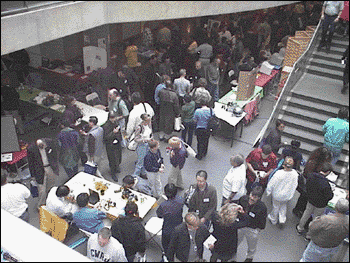
The lower level of the exhibit hall was packed with people and robots.
Fun and Learning at MindFest
by Jonathan Knudsen
O'Reilly & Associates, Inc.
On October 23 and 24, a remarkable event happened at MIT's Media Laboratory [ http://www.media.mit.edu/ ] in Cambridge, Massachusetts. It was MindFest [ http://www.media.mit.edu/mindfest/ ], subtitled "a gathering of playful inventors." Nobody was quite sure what to call it: a conference, a robotics festival, an educational summit, or a gathering of MINDSTORMS™ [ http://www.legomindstorms.com/fans ]. It was a little of each. I was there to see the cool robots and spread the word about my book, The Unofficial Guide to LEGOŽ MINDSTORMS™ Robots [ http://www.oreilly.com/catalog/lmstorms/ ].
Whatever you might call MindFest, about 300 people from diverse backgrounds attended. There were the MIT Media Lab people, LEGO [ http://www.lego.com/ ] employees, LEGO robot geeks like me, teachers, and kids. Both days of the event were filled with panel discussions, ranging from "Artistic Machines" and "Virtual Tinkering" to "Young Inventors" and "Robotics in the Classroom." Concurrent with the panel discussion were classroom-style tutorials and displays in the exhibit hall.

The lower level of the exhibit hall was packed with people
and robots.
The Future of Learning
On a high level, the conference was about the future of learning. MIT professor Mitchel Resnick [ http://mres.www.media.mit.edu/people/mres/ ] set the tone in his Saturday morning keynote speech. At the Media Lab, he said, they are much less interested in information itself and more in creating and building things. They're interested in the kind of learning that results from experimentation and play than from a rigorous scientific method. He cited kindergarten as a good example of exploratory learning. Computers currently are underutilized in this style of learning. Instead of just using computers for information retrieval, Professor Resnick suggested that computers should be used to promote kindergarten-stye learning.
On Sunday morning, the esteemed Seymour Papert [ http://papert.www.media.mit.edu/people/papert/ ] (author of Mindstorms [ http://www.amazon.com/exec/obidos/ASIN/0465046746/ ], the book) followed up on Mitchel Resnick's thoughts by talking about the future of learning. It's clear to him that the current system is breaking down. Although this breakdown is generally known, nobody is thinking in concrete terms about what the educational system of the future will look like.
It's All About Fun
But it wasn't all deep thinking on a societal level. The weekend was highly enjoyable. Between the holographic lollipops and the great robots, there was a lot of fun to be had. And in a way, that was part of the larger picture too. One of the reasons LEGO robots are such a startling innovation is the creative power they place in the hands of children and adults. You have the ability to build and program anything you can imagine. You can learn a lot while you're having fun.
Crickets
The people at the MIT Media Lab get to play with all sorts of cool stuff. Particularly relevant to LEGO robotics were Crickets [ http://el.www.media.mit.edu/people/fredm/projects/cricket/ ], tiny programmable computers. Powered by a 9V battery, a Cricket is less than twice as large as its battery. It can control motors and respond to inputs, just like an RCX brick in a LEGO robot. Will Crickets become an official LEGO product, available to the public? We'll just have to wait and see.
iBalls and iSockets
Sega donated a tiny computer, the Visual Memory Unit (VMU) [ http://www.sega.com/console/index.shtml ], to every MindFest attendee. Looking like a miniaturized GameBoy, the VMU is host to pieces of information, dubbed iBalls by the Media Lab staff. They were tempted to call the VMU an iSocket, as it was a receptacle for iBalls, but they refrained. This left MindFest attendees calling them "iBall thingies" throughout the weekend.
The kicker about these tiny computers was that you could plug your VMU into someone else's VMU and exchange data. The Media Lab constructed a couple of interesting competitions based on this concept, and stations were set up where you could create other iBalls.
"Extreme Mindstorms"
The highlight of the weekend was the "Extreme Mindstorms" panel discussion. This was a dream team of RCX hacking, including:
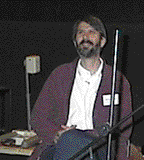
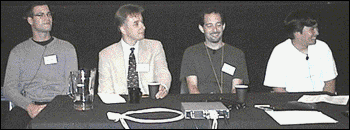
The Pantheon of RCX hacking. From left to right, Michael Gasperi,
Markus Noga, Ralph Hempel, Dave Baum, and Kekoa Proudfoot.
Each of the panel participants gave a short presentation. Ralph Hempel talked about the lunar landing mission, thirty years ago. People sometimes complain about the limitations of the RCX, but it's a very capable machine. With the RCX, Ralph pointed out, you hold in your hand all the computing power that sent a man to the moon.
Along the same lines, Markus Noga noted that there's a certain form to be followed in any creative endeavor: the border of a painter's canvas, or the form of a sonnet. "Form is liberating," he declared. The structure of the RCX was just another form to be followed in creating legOS. "Creativity," he said, "unfolds into the given space."
Tic-tac-toe in Italian
Many attendees flew to MIT from abroad. LEGO employees came from Denmark and England. Other LEGO robot enthusiasts flew in from Italy, the Netherlands, and even Japan.
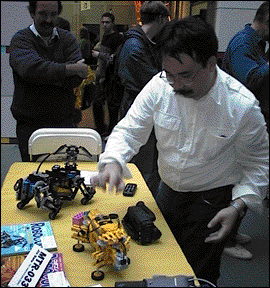
Jin Sato [ http://www.mi-ra-i.com/JinSato/MindStorms/index-e.html
] showed off his walking robots.
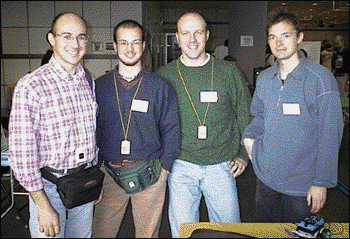
From left to right: Mario Ferrari, Guilio Ferrari, Marco Beri,
and Eric Brok [ http://homepages.svc.fcj.hvu.nl/brok//legomind/robo/ ].
Mario Ferrari [ http://www.geocities.com/~marioferrari/lego_mindstorm.html ], Guilio Ferrari, and Marco Beri were showing off a robot that plays tic-tac-toe. Using a light sensor, the robot scanned the playing board to figure out where pieces had been played. Then it planned a move and physically placed a piece on the board. /p>
RRalph Hempel demonstrated a robot that navigates a maze drawn on a piece of paper. He inverted the problem, so that instead of a robot moving through the maze, the maze moved through a robot that looked a lot like an optical scanner. In a tutorial session, he discussed depth-first and breadth-first maze solving algorithms. The demonstration was implemented entirely in pbFORTH [ http://www.hempeldesigngroup.com/lego/pbFORTH/ ].
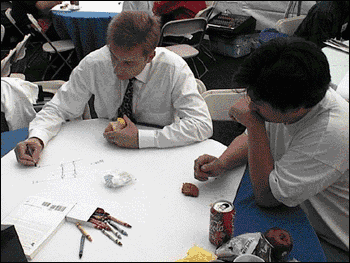
During lunch, Ralph Hempel just couldn't resist drawing a schematic
of a Mindstorms sensor signal splitter. Kekoa Proudfoot looked on in amazement.
Other interesting creations included the Pipe-Bot, a robot that scurries through PVC pipe, and the brick sorter, a robot that sorts LEGO bricks into piles based on their color. Robert Munafo [ http://www.mrob.com/lego/index.html ] demonstrated RilyBot 4, a robot that can be trained by moving it around. It remembers the movements and replays them later.
II put together the Minerva and Minerva Remote projects from my book [ http://www.oreilly.com/catalog/lmstorms/ ]. Curious onlookers had fun controlling Minerva using the remote control, picking up Smarties [ http://www.smarties.com/ ] and moving them across a table.
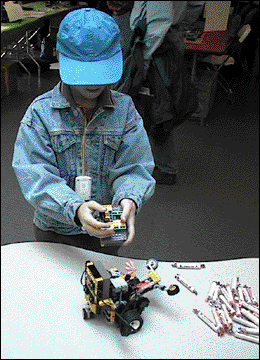
An inquisitive onlooker plays with Minerva and the Minerva
Remote, projects from The Unofficial Guide to LEGOŽ MINDSTORMS™ Robots [ http://www.oreilly.com/catalog/lmstorms/
].
Construction Zone/p>
One of the featured attractions at MindFest was the Construction Zone. The MIT staff turned one of their large rooms (the "Cube") into a big playground for kids and adults. Complete with RCXs, Crickets, motors, sensors, computers, and more LEGO bricks than you've probably ever seen, the Construction Zone contained a huge set of raw material for creative building.
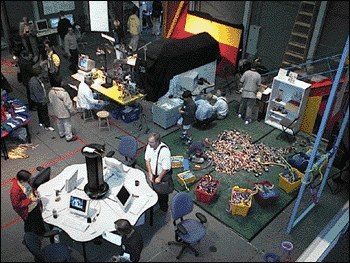
The Construction Zone was a hotbed of raw materials and creativity.
Summary
It was a great weekend, filled with fascinating people and fascinating robots. I hope they do this again next year.
Jonathan Knudsen [ jonathan@oreilly.com ] is an author and developer at O'Reilly & Associates [ http://www.oreilly.com/ ]. He is the author of Java Cryptography [ http://www.oreilly.com/catalog/javacrypt/ ], Java 2D Graphics [ http://www.oreilly.com/catalog/java2d/ ], and The Unofficial Guide to LEGOŽ MINDSTORMS™ Robots [http://www.oreilly.com/catalog/lmstorms/ ].
Copyright 1999